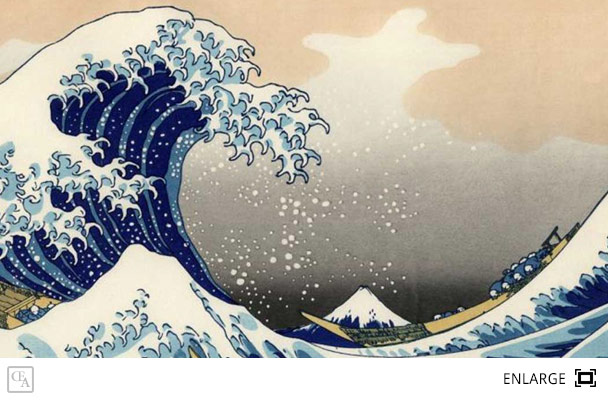
The Wave itself was produced during the Edo period, likely at some point in the 1830's. It is the first image in a series created by Hokusai that deals with multiple views of Mount Fuji, and is probably Hokusai's most well-known work, recognized by many the world over as an example of typical Japanese traditional art. It is the subject of much imitation and parody, and is one of the best-known woodblock works of its time period.
The work itself is an image of a huge wave in the Kanagawa prefecture, with several boats floating in the water. By the appearance of the sky, the scene appears to take place in the morning, with the viewer of the illustration facing West as the sun begins to rise behind him. The print is most likely a depiction of an unexpected rogue wave wreaking havoc not far from the shore, and in the background one can see Mount Fuji, which falls in line with the theme of the series in which this print appears. The mountain is capped with snow and stands majestically as a common symbol of Japan, which has probably contributed to the print's enduring role as one of the most recognizable examples of Japanese art. The boats in the water are also very historically Japanese, and were the vessels that typically carried fish to shore during the Edo period. Peering closely at the image, the viewer can recognize groups of men manning the oars of the boats, though they are dwarfed by the huge size of the wave that is about to overcome them. Roughly 30 human figures in total are visible among the waters. The words that are inscribed on the print in the corner denote the series it belongs to (Thirty-six Views of Mount Fuji) and the work's name (Offshore from Kanagawa / Beneath the wave), as well as the artists signature.
This image, like many other woodblock prints of its time, started its life as a sketch, that was then converted into a relief image by being carved into a block of wood by a master carver. These blocks—of which there could be several, depending on how many colors were needed—could then be pressed onto paper to produce the desired image. One block could endure thousands of printings in this way before deterioration set in. Woodblock prints like these were often used to illustrate books, and in fact were at first largely used in the illustration of Buddhist texts.
Many prints of this work were made, and they are housed in both Japanese and Western museums and collections. Prints can be found in France, Australia, the U.K., and in major cities of the United States.
 Arts3 Network
Website edition
Arts3 Network
Website edition